In the KeyNet toolbar, click Cross-section
toolbar, click Cross-section  to open the Cross-section form. You can also open this form through the telecom premises’ list of Devices or through the list of Telecom premises of the circuit section by clicking the right mouse button and selecting it in the displayed menu. The Cross-section
to open the Cross-section form. You can also open this form through the telecom premises’ list of Devices or through the list of Telecom premises of the circuit section by clicking the right mouse button and selecting it in the displayed menu. The Cross-section  form displays the connections between the connectors in the selected telecom premises and device and information on the related circuits. This form is also used for reserving a connector or sub-circuit for a circuit, for switching pairs, and for releasing a reservation.
form displays the connections between the connectors in the selected telecom premises and device and information on the related circuits. This form is also used for reserving a connector or sub-circuit for a circuit, for switching pairs, and for releasing a reservation.
Cross-section form
The Cross-section  form displays information on the selected telecom premises, such as identifier, name, type, usage state, address, ownership, and the devices on the telecom premises. The connectors and related connections of an activated device are listed in a separate section on the form.
form displays information on the selected telecom premises, such as identifier, name, type, usage state, address, ownership, and the devices on the telecom premises. The connectors and related connections of an activated device are listed in a separate section on the form.
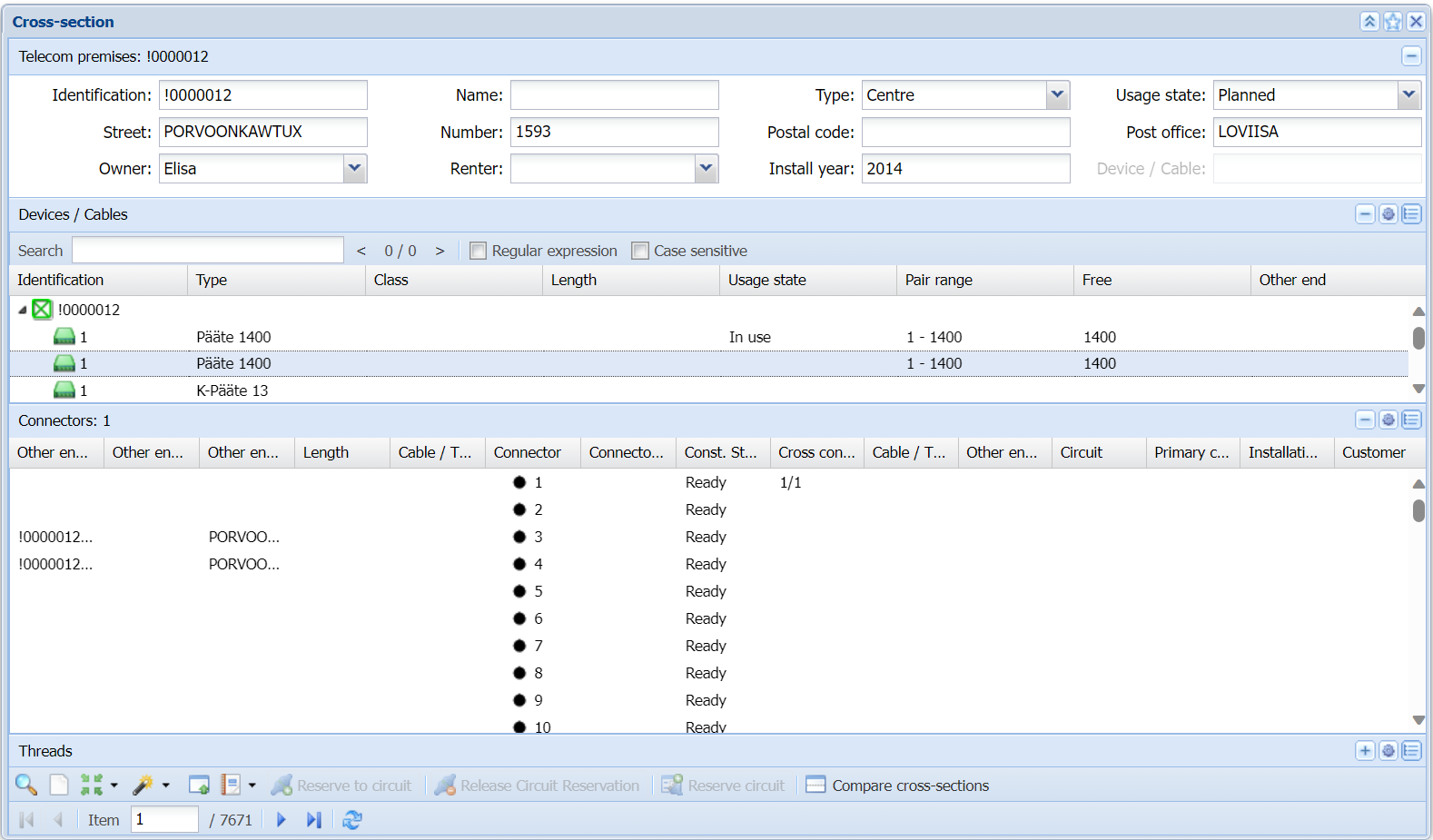
Search functions on the Cross-section form
There are several options for opening telecom premises on a form, such as using its identifier, using the Pick from map tool, or clicking Pick from telecom premises
tool, or clicking Pick from telecom premises form. The available search criteria include all the fields of the telecom premises form, and search criteria can be entered in full or partially with % as the wildcard character. The visibility of devices and cables in the Devices / Cables grid can be determined before a search by using the Show devices
form. The available search criteria include all the fields of the telecom premises form, and search criteria can be entered in full or partially with % as the wildcard character. The visibility of devices and cables in the Devices / Cables grid can be determined before a search by using the Show devices and Show cables
and Show cables buttons in the upper right corner of the grid. Only Show devices
buttons in the upper right corner of the grid. Only Show devices activated by default.
activated by default.
You can also retrieve telecom premises based on the device identifier. Use the Device field to retrieve to the Cross-section form all the telecom premises that include the device identifier entered as a search criterion. The Device field is active when the form is empty, or when you click Clear .
.
Compare logical cross sections
You can view several different cross-sections at the same time by using the Compare cross-sections  tool. This tool enables simultaneous comparisons such as comparisons between various devices, their connectors, and circuits in some specific telecom premises. The Cross-section
tool. This tool enables simultaneous comparisons such as comparisons between various devices, their connectors, and circuits in some specific telecom premises. The Cross-section from which the Compare logical cross- sections function is activated will become a so-called primary form, and the Cross-section forms used for comparison will be named in accordance with the header >Cross-section.
from which the Compare logical cross- sections function is activated will become a so-called primary form, and the Cross-section forms used for comparison will be named in accordance with the header >Cross-section.
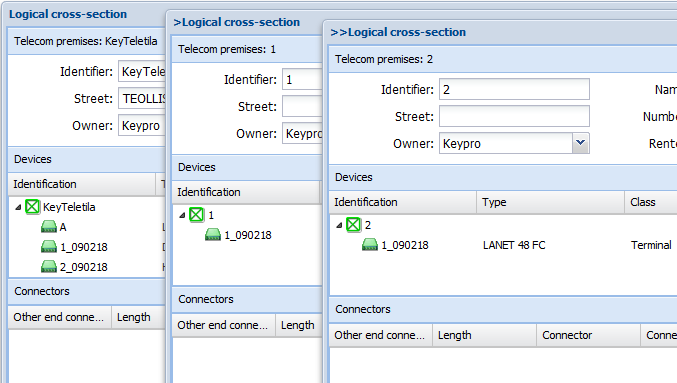
Devices / Cables
The Devices/Cables list includes information on the device, such as the device identification, type, class, usage state, and pair range. The column named Free indicates how many connectors in the device in question are available. The OE telecom premises column displays the telecom premises that the device in question can access.
You can also use the Search functionality to look devices and cables related to the telecom premises. The corresponding text written in the field is highlighted on the list below. Turning to next page of the form resets the Search functionality.
- Turning on Case sensitive activates a search that have strict checking of lower and upper cases. For example, if you search the word "in use" the system will only search for that desired word and will exclude words like "In use" from the search because it has an upper case letter.
- The Regular expression allows you to search for specific patterns, as opposed to certain terms and phrases.
Devices / Cable filtering
In the top-right corner of the Devices section, click Device/Cable filter . Filter devices based on Identification, Type, Class, Usage state, Other end, Service and Connector and cables based on Identification, Type, Class, Usage state, Other end, Length and Pair / Thread. Select or enter the filters and click Update to view the filtered devices on the Devices /Cables list.
. Filter devices based on Identification, Type, Class, Usage state, Other end, Service and Connector and cables based on Identification, Type, Class, Usage state, Other end, Length and Pair / Thread. Select or enter the filters and click Update to view the filtered devices on the Devices /Cables list.
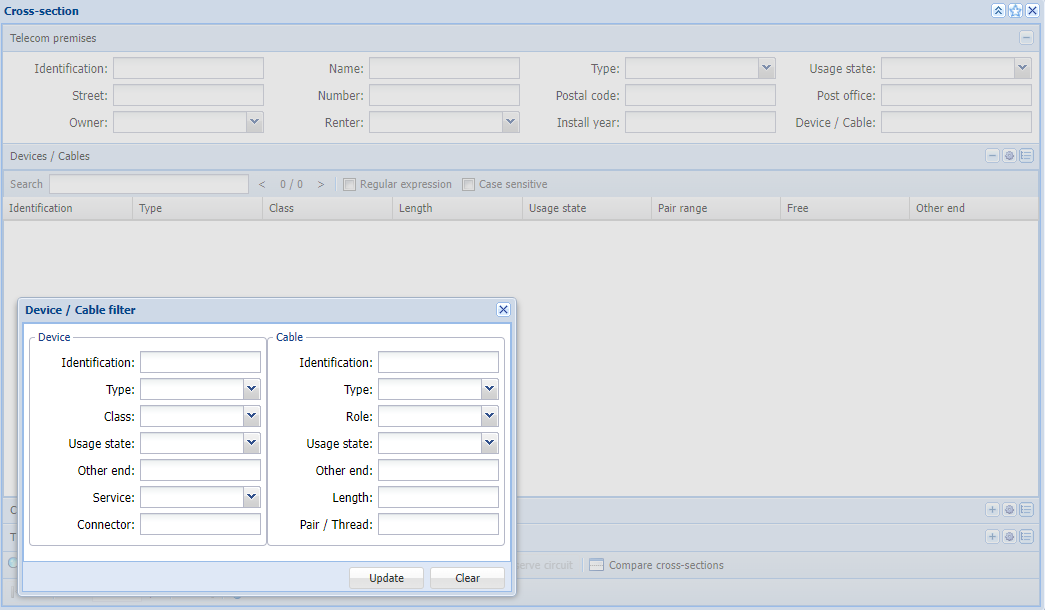
When devices are filtered, the form functions are applied to a limited group of devices. In the top-right corner of the Devices section, click Clear device filter to remove filters.
to remove filters.
Functions of the Device/Cable context menu
On the Devices/Cables list, click telecom premises or a device using the right mouse button. The displayed context menu includes the following functions:
- Click Open telecom premises
 to open the Telecom premises
to open the Telecom premises form for the telecom premises in question.
form for the telecom premises in question. - Click Open in -> Device form
 to open the Device
to open the Device form that includes the information on the selected device.
form that includes the information on the selected device. - Click Open in –> Telecom premises device list
 to open the Devices tab of the Telecom premises form and to view information on the selected device.
to open the Devices tab of the Telecom premises form and to view information on the selected device. - Click Open in –> Route follower
 to open the Route follower
to open the Route follower form with information on the telecom premises in question.
form with information on the telecom premises in question. - Click Open in –> Affected area
 to open the Route follower
to open the Route follower form pre-completed with the selected device’s connectors and cables connected to the connectors. The route follower highlights the connection routes that are connected to the selected device either directly or over logical cross-connections.
form pre-completed with the selected device’s connectors and cables connected to the connectors. The route follower highlights the connection routes that are connected to the selected device either directly or over logical cross-connections. - Click Print cross-section report (pdf) / (xlsx)
 to create an Excel or PDF report on the connectors and connections of the selected device (also with related sub-devices).
to create an Excel or PDF report on the connectors and connections of the selected device (also with related sub-devices). - Expand/collapse opens/closes the devices in the device’s sub-hierarchy.
- Click Edit connectors
 to open the connectors for form, on which you can name and edit the connectors of the device.
to open the connectors for form, on which you can name and edit the connectors of the device. - Click Circuits
 to open the Circuit list of device’s connections.
to open the Circuit list of device’s connections. - Click Update logical connections
 to create or update a device’s logical connections.
to create or update a device’s logical connections.
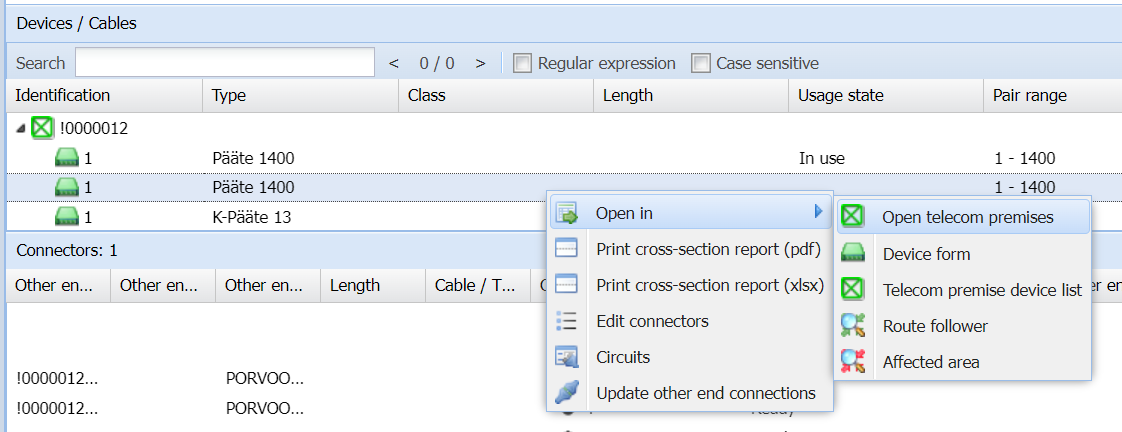
Connectors
The columns in the Connectors list may include the following:
Other end connector | The connector to which the viewed connector has a logical connection. Displayed in the column: telecom premises/device/connector |
| Other end name | The name of the other end connector |
| Other end type | The type of the other end connector (column hidden by default) |
| Other end technical info | The technical information of the other end connector (column hidden by default) |
| Other end address | The address of the other end connector |
| Other end zipcode & city | The zipcode and city of the other end connector (column hidden by default) |
| Other end municipality | The municipality of the other end connector (column hidden by default) |
Length | The total length between the connectors. |
| Cable / Thread | Indicates which strand the device is connected to in the cable |
Connector | The name of the connector. |
| Connector number | The connector number (column hidden by default) |
Connector type | The abbreviation of the connector type. |
Const. state | The construction state of the connector. If the construction state is not built, it is not shown on the connector list. |
| Owner | The name of the circuit’s owner. Access to the Customer form (column hidden by default) |
| Connector remarks | Additional free-form details related to the connector (column hidden by default) |
Cross connection | The connector to which the connector of the row viewed has a cross-connection. Displayed in the column: device/connector. |
| Cable / Thread | Indicates which thread the device is connected to in the cable |
Other end connector | The other end connector of the cross-connection. Displayed in the column: telecom premises/device/connector |
| Other end name | The other end name of the cross connection (column hidden by default) |
| Other end type | The other end type of the cross connection (column hidden by default) |
| Other end technical info | Th other end technical info of the cross connection (column hidden by default) |
| Other end address | The other end address of the cross connection (column hidden by default) |
| Other end zipcode & city | The other end zipcode and city of the cross connection (column hidden by default) |
| Other end municipality | The other end municipality (column hidden by default) |
Circuit | The circuit that has been reserved for the connector. Displayed as: circuit (abbreviation of the usage state). |
| Circuit Identifier 2 | The second identifier of the circuit (column hidden by default) |
| Primary circuit | Used as a primary circuit |
Installation address | The street name and number of the customer’s installation address (the address of the starting point is used by default, and the selection between the starting/ending point can be defined in the database) |
| Installation address (2nd) | Secondary installation address (column hidden by default) |
Customer | The name of the customer linked to the circuit. Access to the Customer form. |
The colours on the connection list of the Cross-section form indicate the usage state of the connector in question:
form indicate the usage state of the connector in question:
In use |
Pre-connected |
Partially pre-connected |
Soon in use, Soon free |
Free |
Ready to be connected is used if the TTMi interface is in use.
The Connectors list highlights those device connectors that involve a multi-use (meaning two or more circuits reserve the same device connector) with the symbol. On the Circuit column, you can also see the amount of reservations in brackets:
symbol. On the Circuit column, you can also see the amount of reservations in brackets:

Changing logical reservations for connectors
On the Cross-section  form, you can change the circuit reserved for a device’s connector, or you can change the circuits to go through the same device’s other connector that has no circuits.
form, you can change the circuit reserved for a device’s connector, or you can change the circuits to go through the same device’s other connector that has no circuits.
On the form, select the connector with a circuit or circuits. Alternatively, you can also select an individual circuit row by opening the connector’s circuits for viewing.
Then, click Change of logical reservation in the menu displayed when you click the right mouse button. Except for the Connectors section, all other sections on the Cross-section
in the menu displayed when you click the right mouse button. Except for the Connectors section, all other sections on the Cross-section  form will be disabled.
form will be disabled.
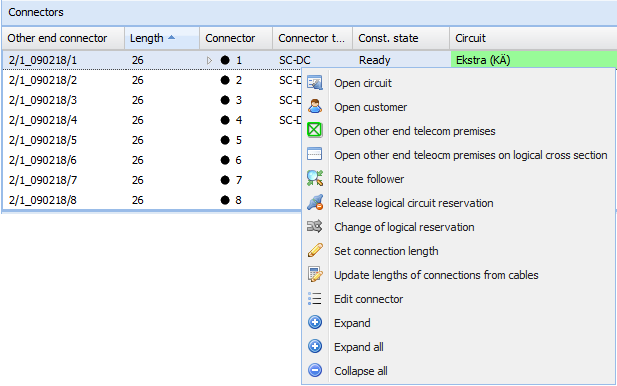
Next, in the same device, select a connector that has no reservations. Click the right mouse button and select either Accept reservation change or Cancel reservation change. Select Route follower to check the route.

Releasing a connector reservation
To start the release of a circuit reservation, select the reserved connector on the list and click Release circuit reservation  in the tool bar at the bottom of the form. You can also activate this function by clicking a connector with the right mouse button (Release logical circuit reservation).
in the tool bar at the bottom of the form. You can also activate this function by clicking a connector with the right mouse button (Release logical circuit reservation).
You will see the following question: Are you sure you want to release the circuit´s reservation? If you answer Yes, the reservations for the selected connector and connection will be removed from the circuit in question.
Filtering connectors
In the top-right corner of the Connectors section, click Connector filter  . Filter connectors based on the Connector, Connector type, Owner, Remarks, Circuit, Inst. address, Other end, Other end address, Other end type, Connector range, Const. State, Service, Usage state, Customer, Length and Other end name. To view only connectors that are not reserved for circuits, select the Free only checkbox. Select or enter the filters and click Update to view the filtered connectors on the Connectors list.
. Filter connectors based on the Connector, Connector type, Owner, Remarks, Circuit, Inst. address, Other end, Other end address, Other end type, Connector range, Const. State, Service, Usage state, Customer, Length and Other end name. To view only connectors that are not reserved for circuits, select the Free only checkbox. Select or enter the filters and click Update to view the filtered connectors on the Connectors list.
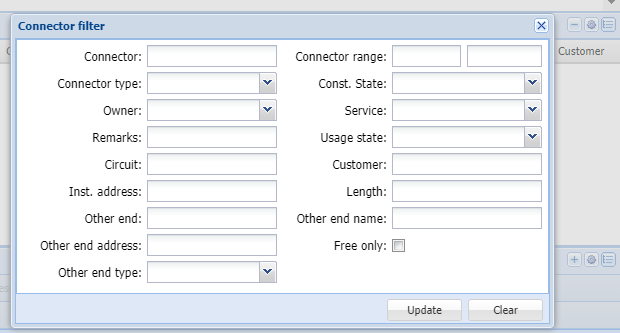
When devices are filtered, the form functions are applied to a limited group of devices.
In the top-right corner of the Connectors section, click Clear connector filter  to remove filters.
to remove filters.
Editing connectors
You can open the Connector form for editing from the Cross-section form or Telecom premises form. More information on editing connectors is provided in the chapter Managing connectors.
Click the right mouse button and select in the context menu  Edit connectors either in the Devices section (the connectors of all devices on the telecom premises or all the connectors of a device) or in the Connectors section (individual connectors). To activate the numbering of connectors in the view, go to the drop-down menu for Columns and select Number. The connector number column is hidden by default.
Edit connectors either in the Devices section (the connectors of all devices on the telecom premises or all the connectors of a device) or in the Connectors section (individual connectors). To activate the numbering of connectors in the view, go to the drop-down menu for Columns and select Number. The connector number column is hidden by default.
Connector splitting
- In the Connectors section, select the connector you want to split. Note that you cannot split a reserved connector.
- In the context menu, select
 Connector splitting.
Connector splitting.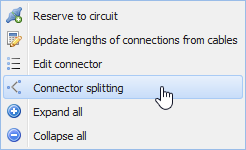
- Select the type of the new connector in the drop-down menu for Connector type.

TIP: If no suitable connectors can be found in the database, check that the connector type has been defined for the connector you selected. More information on defining connector types is provided in the chapter Editing connectors.

Click Split to split the connector.
Updating lengths of connections
Define the length of a connection by choosing  Set connection length in the context menu, while the mouse pointer is positioned over the required connector.
Set connection length in the context menu, while the mouse pointer is positioned over the required connector.

 Use the Update lengths of connections from cables function to update the lengths of all logical connections based on the actual cable lengths.
Use the Update lengths of connections from cables function to update the lengths of all logical connections based on the actual cable lengths.
